IoT in Smart Offices: Network Design, Security, and Technology Review
VerifiedAdded on 2023/06/07
|8
|1999
|403
Report
AI Summary
This report provides an overview of Internet of Things (IoT) applications in smart office network design. It reviews past and current literature, focusing on the use of technologies like DHCP servers, remote servers, and wireless routers to create secure and efficient networks. The report identifies challenges such as scalability and security vulnerabilities, proposing solutions like discrete event simulation and packet tracer for troubleshooting. It also recommends using proper protocols and intelligent systems to enhance network design, highlighting the importance of wireless technologies like Wi-Fi, Bluetooth, and ZigBee. The study concludes that packet tracer and DHCP servers are valuable tools for developing robust networking systems in smart office environments, emphasizing the need for strong security measures to prevent data leakage and resolve cloud computing issues. The assignment also includes a practical implementation using Cisco Packet Tracer to simulate a smart office network controlled remotely, detailing device configurations and network designs for both the main and branch offices.

Running head: Internet of Things (IoT)
Internet of Things (IoT)
(Milestone: 4)
Internet of Things (IoT)
(Milestone: 4)
Paraphrase This Document
Need a fresh take? Get an instant paraphrase of this document with our AI Paraphraser
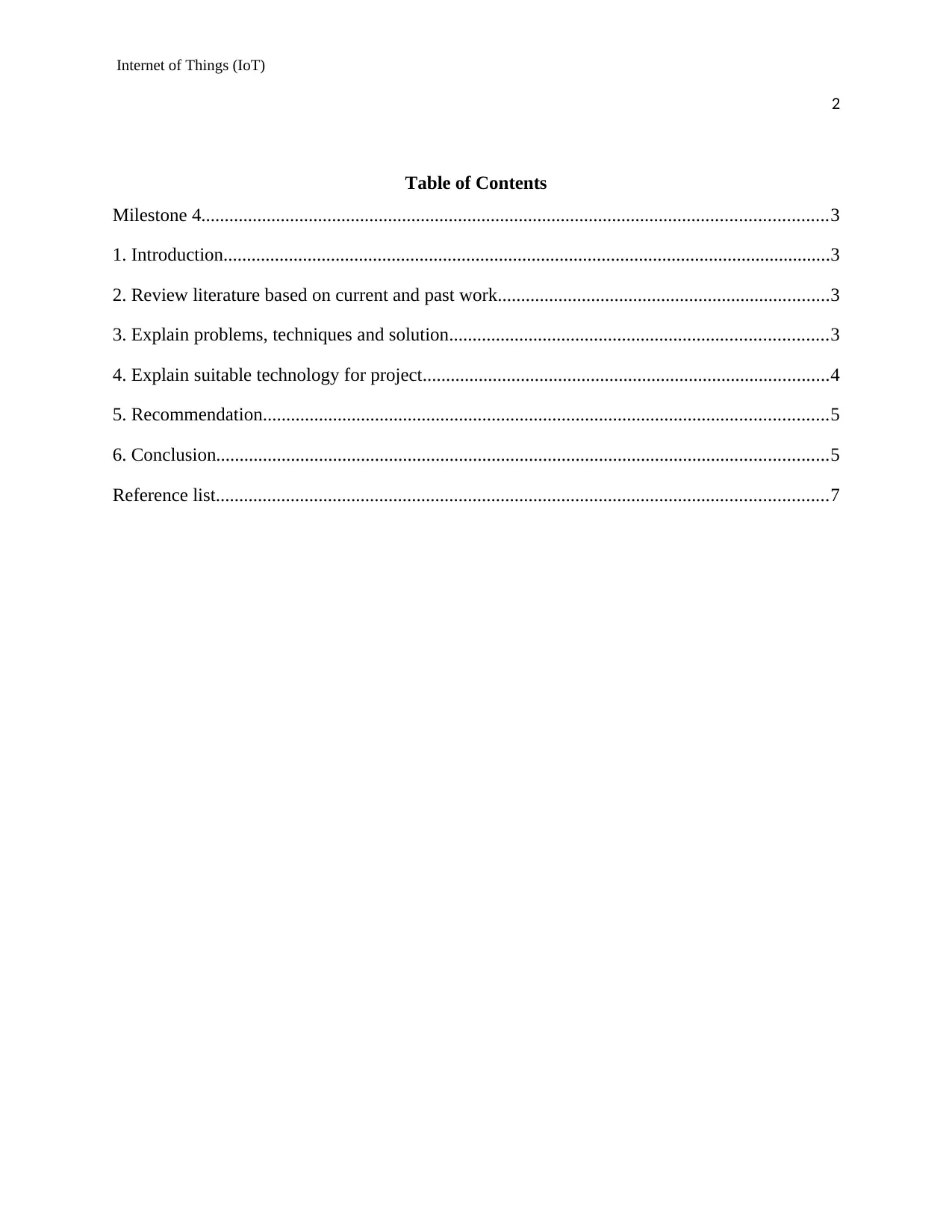
Internet of Things (IoT)
2
Table of Contents
Milestone 4......................................................................................................................................3
1. Introduction..................................................................................................................................3
2. Review literature based on current and past work.......................................................................3
3. Explain problems, techniques and solution.................................................................................3
4. Explain suitable technology for project.......................................................................................4
5. Recommendation.........................................................................................................................5
6. Conclusion...................................................................................................................................5
Reference list...................................................................................................................................7
2
Table of Contents
Milestone 4......................................................................................................................................3
1. Introduction..................................................................................................................................3
2. Review literature based on current and past work.......................................................................3
3. Explain problems, techniques and solution.................................................................................3
4. Explain suitable technology for project.......................................................................................4
5. Recommendation.........................................................................................................................5
6. Conclusion...................................................................................................................................5
Reference list...................................................................................................................................7
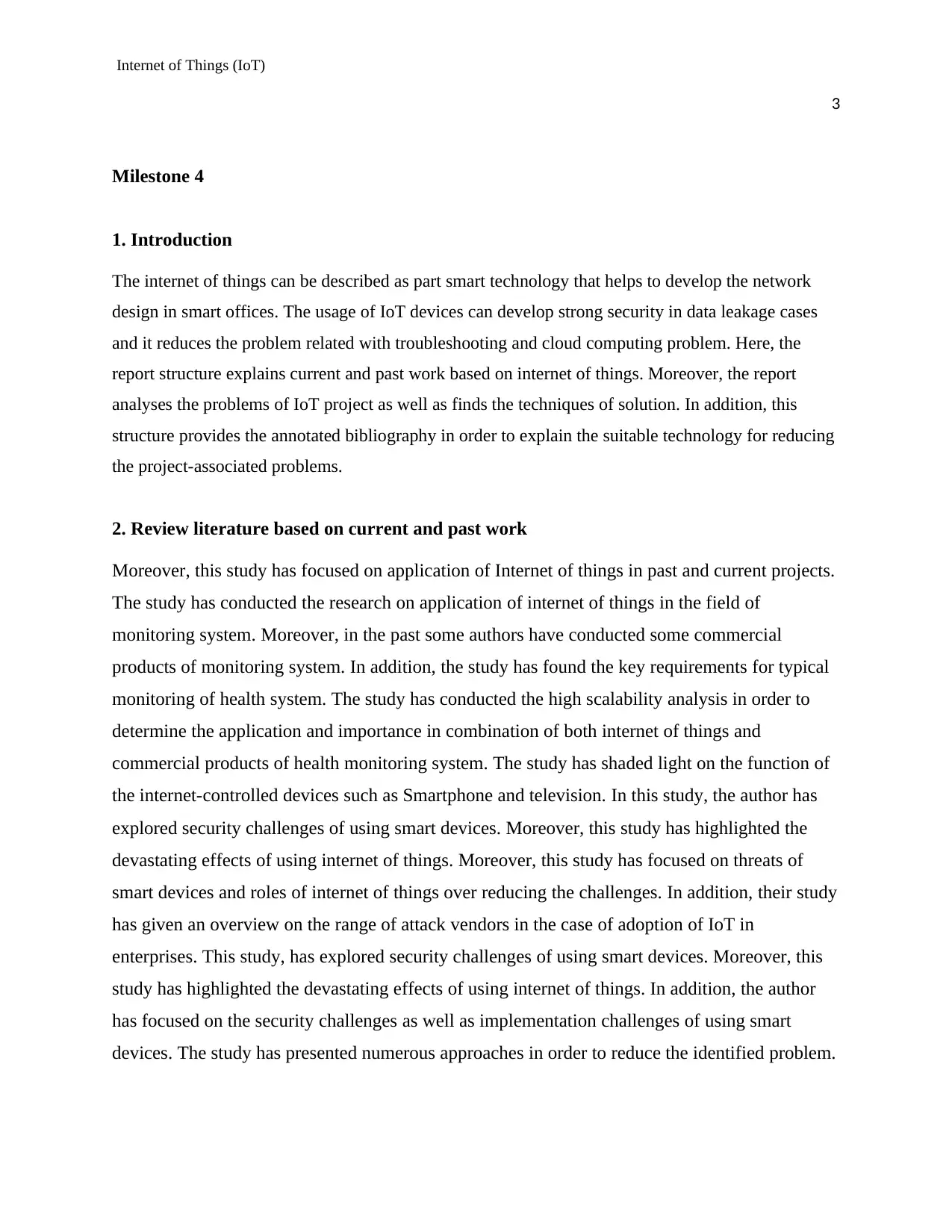
Internet of Things (IoT)
3
Milestone 4
1. Introduction
The internet of things can be described as part smart technology that helps to develop the network
design in smart offices. The usage of IoT devices can develop strong security in data leakage cases
and it reduces the problem related with troubleshooting and cloud computing problem. Here, the
report structure explains current and past work based on internet of things. Moreover, the report
analyses the problems of IoT project as well as finds the techniques of solution. In addition, this
structure provides the annotated bibliography in order to explain the suitable technology for reducing
the project-associated problems.
2. Review literature based on current and past work
Moreover, this study has focused on application of Internet of things in past and current projects.
The study has conducted the research on application of internet of things in the field of
monitoring system. Moreover, in the past some authors have conducted some commercial
products of monitoring system. In addition, the study has found the key requirements for typical
monitoring of health system. The study has conducted the high scalability analysis in order to
determine the application and importance in combination of both internet of things and
commercial products of health monitoring system. The study has shaded light on the function of
the internet-controlled devices such as Smartphone and television. In this study, the author has
explored security challenges of using smart devices. Moreover, this study has highlighted the
devastating effects of using internet of things. Moreover, this study has focused on threats of
smart devices and roles of internet of things over reducing the challenges. In addition, their study
has given an overview on the range of attack vendors in the case of adoption of IoT in
enterprises. This study, has explored security challenges of using smart devices. Moreover, this
study has highlighted the devastating effects of using internet of things. In addition, the author
has focused on the security challenges as well as implementation challenges of using smart
devices. The study has presented numerous approaches in order to reduce the identified problem.
3
Milestone 4
1. Introduction
The internet of things can be described as part smart technology that helps to develop the network
design in smart offices. The usage of IoT devices can develop strong security in data leakage cases
and it reduces the problem related with troubleshooting and cloud computing problem. Here, the
report structure explains current and past work based on internet of things. Moreover, the report
analyses the problems of IoT project as well as finds the techniques of solution. In addition, this
structure provides the annotated bibliography in order to explain the suitable technology for reducing
the project-associated problems.
2. Review literature based on current and past work
Moreover, this study has focused on application of Internet of things in past and current projects.
The study has conducted the research on application of internet of things in the field of
monitoring system. Moreover, in the past some authors have conducted some commercial
products of monitoring system. In addition, the study has found the key requirements for typical
monitoring of health system. The study has conducted the high scalability analysis in order to
determine the application and importance in combination of both internet of things and
commercial products of health monitoring system. The study has shaded light on the function of
the internet-controlled devices such as Smartphone and television. In this study, the author has
explored security challenges of using smart devices. Moreover, this study has highlighted the
devastating effects of using internet of things. Moreover, this study has focused on threats of
smart devices and roles of internet of things over reducing the challenges. In addition, their study
has given an overview on the range of attack vendors in the case of adoption of IoT in
enterprises. This study, has explored security challenges of using smart devices. Moreover, this
study has highlighted the devastating effects of using internet of things. In addition, the author
has focused on the security challenges as well as implementation challenges of using smart
devices. The study has presented numerous approaches in order to reduce the identified problem.
⊘ This is a preview!⊘
Do you want full access?
Subscribe today to unlock all pages.

Trusted by 1+ million students worldwide
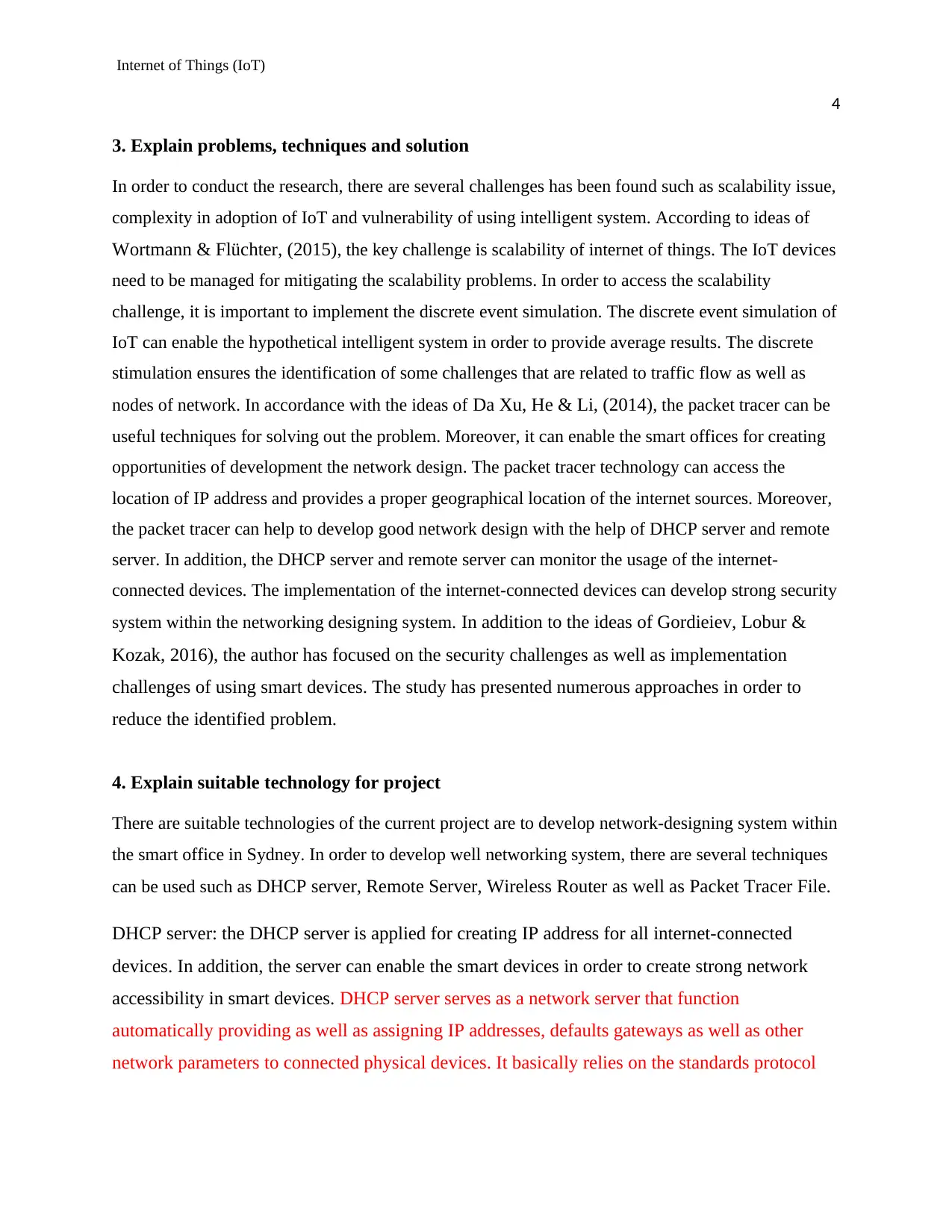
Internet of Things (IoT)
4
3. Explain problems, techniques and solution
In order to conduct the research, there are several challenges has been found such as scalability issue,
complexity in adoption of IoT and vulnerability of using intelligent system. According to ideas of
Wortmann & Flüchter, (2015), the key challenge is scalability of internet of things. The IoT devices
need to be managed for mitigating the scalability problems. In order to access the scalability
challenge, it is important to implement the discrete event simulation. The discrete event simulation of
IoT can enable the hypothetical intelligent system in order to provide average results. The discrete
stimulation ensures the identification of some challenges that are related to traffic flow as well as
nodes of network. In accordance with the ideas of Da Xu, He & Li, (2014), the packet tracer can be
useful techniques for solving out the problem. Moreover, it can enable the smart offices for creating
opportunities of development the network design. The packet tracer technology can access the
location of IP address and provides a proper geographical location of the internet sources. Moreover,
the packet tracer can help to develop good network design with the help of DHCP server and remote
server. In addition, the DHCP server and remote server can monitor the usage of the internet-
connected devices. The implementation of the internet-connected devices can develop strong security
system within the networking designing system. In addition to the ideas of Gordieiev, Lobur &
Kozak, 2016), the author has focused on the security challenges as well as implementation
challenges of using smart devices. The study has presented numerous approaches in order to
reduce the identified problem.
4. Explain suitable technology for project
There are suitable technologies of the current project are to develop network-designing system within
the smart office in Sydney. In order to develop well networking system, there are several techniques
can be used such as DHCP server, Remote Server, Wireless Router as well as Packet Tracer File.
DHCP server: the DHCP server is applied for creating IP address for all internet-connected
devices. In addition, the server can enable the smart devices in order to create strong network
accessibility in smart devices. DHCP server serves as a network server that function
automatically providing as well as assigning IP addresses, defaults gateways as well as other
network parameters to connected physical devices. It basically relies on the standards protocol
4
3. Explain problems, techniques and solution
In order to conduct the research, there are several challenges has been found such as scalability issue,
complexity in adoption of IoT and vulnerability of using intelligent system. According to ideas of
Wortmann & Flüchter, (2015), the key challenge is scalability of internet of things. The IoT devices
need to be managed for mitigating the scalability problems. In order to access the scalability
challenge, it is important to implement the discrete event simulation. The discrete event simulation of
IoT can enable the hypothetical intelligent system in order to provide average results. The discrete
stimulation ensures the identification of some challenges that are related to traffic flow as well as
nodes of network. In accordance with the ideas of Da Xu, He & Li, (2014), the packet tracer can be
useful techniques for solving out the problem. Moreover, it can enable the smart offices for creating
opportunities of development the network design. The packet tracer technology can access the
location of IP address and provides a proper geographical location of the internet sources. Moreover,
the packet tracer can help to develop good network design with the help of DHCP server and remote
server. In addition, the DHCP server and remote server can monitor the usage of the internet-
connected devices. The implementation of the internet-connected devices can develop strong security
system within the networking designing system. In addition to the ideas of Gordieiev, Lobur &
Kozak, 2016), the author has focused on the security challenges as well as implementation
challenges of using smart devices. The study has presented numerous approaches in order to
reduce the identified problem.
4. Explain suitable technology for project
There are suitable technologies of the current project are to develop network-designing system within
the smart office in Sydney. In order to develop well networking system, there are several techniques
can be used such as DHCP server, Remote Server, Wireless Router as well as Packet Tracer File.
DHCP server: the DHCP server is applied for creating IP address for all internet-connected
devices. In addition, the server can enable the smart devices in order to create strong network
accessibility in smart devices. DHCP server serves as a network server that function
automatically providing as well as assigning IP addresses, defaults gateways as well as other
network parameters to connected physical devices. It basically relies on the standards protocol
Paraphrase This Document
Need a fresh take? Get an instant paraphrase of this document with our AI Paraphraser
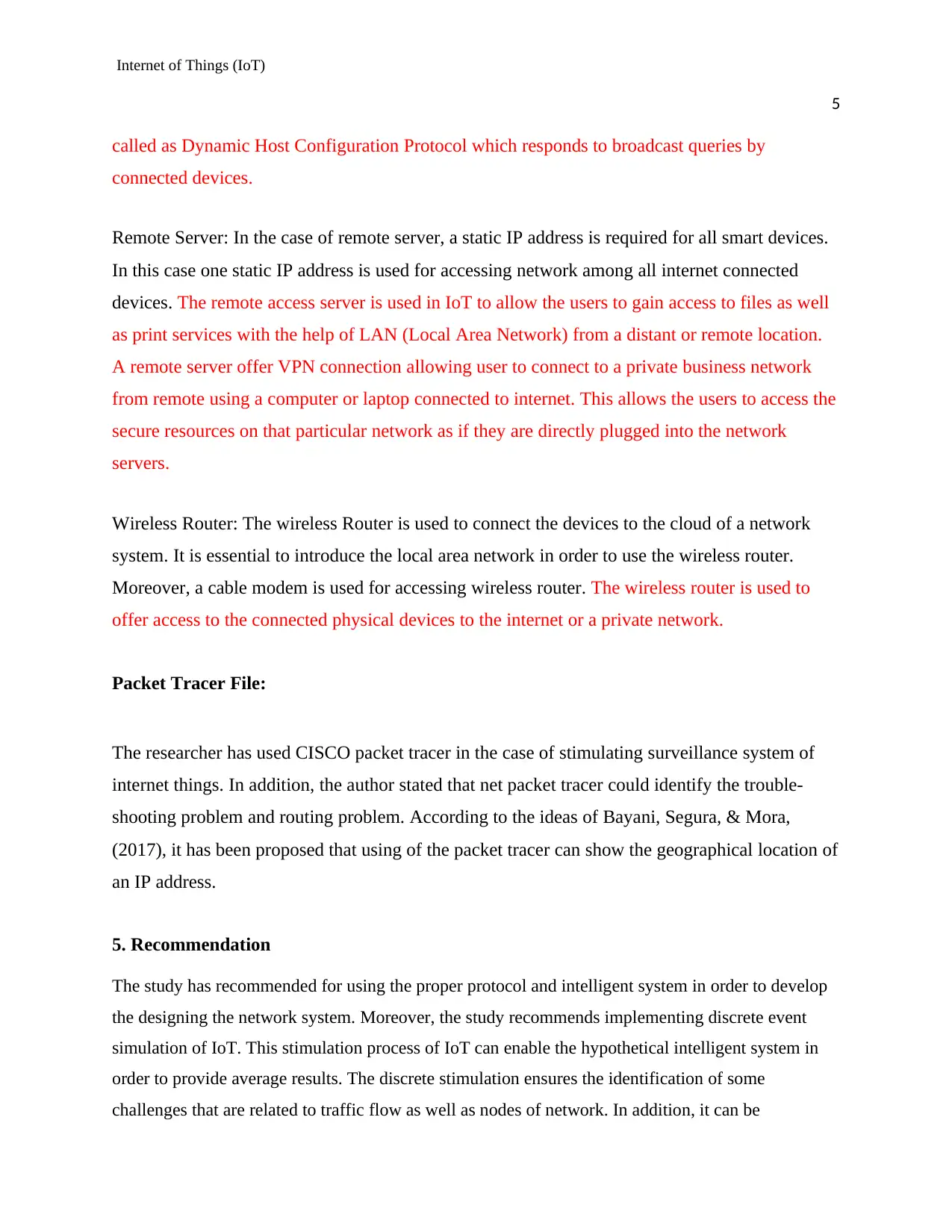
Internet of Things (IoT)
5
called as Dynamic Host Configuration Protocol which responds to broadcast queries by
connected devices.
Remote Server: In the case of remote server, a static IP address is required for all smart devices.
In this case one static IP address is used for accessing network among all internet connected
devices. The remote access server is used in IoT to allow the users to gain access to files as well
as print services with the help of LAN (Local Area Network) from a distant or remote location.
A remote server offer VPN connection allowing user to connect to a private business network
from remote using a computer or laptop connected to internet. This allows the users to access the
secure resources on that particular network as if they are directly plugged into the network
servers.
Wireless Router: The wireless Router is used to connect the devices to the cloud of a network
system. It is essential to introduce the local area network in order to use the wireless router.
Moreover, a cable modem is used for accessing wireless router. The wireless router is used to
offer access to the connected physical devices to the internet or a private network.
Packet Tracer File:
The researcher has used CISCO packet tracer in the case of stimulating surveillance system of
internet things. In addition, the author stated that net packet tracer could identify the trouble-
shooting problem and routing problem. According to the ideas of Bayani, Segura, & Mora,
(2017), it has been proposed that using of the packet tracer can show the geographical location of
an IP address.
5. Recommendation
The study has recommended for using the proper protocol and intelligent system in order to develop
the designing the network system. Moreover, the study recommends implementing discrete event
simulation of IoT. This stimulation process of IoT can enable the hypothetical intelligent system in
order to provide average results. The discrete stimulation ensures the identification of some
challenges that are related to traffic flow as well as nodes of network. In addition, it can be
5
called as Dynamic Host Configuration Protocol which responds to broadcast queries by
connected devices.
Remote Server: In the case of remote server, a static IP address is required for all smart devices.
In this case one static IP address is used for accessing network among all internet connected
devices. The remote access server is used in IoT to allow the users to gain access to files as well
as print services with the help of LAN (Local Area Network) from a distant or remote location.
A remote server offer VPN connection allowing user to connect to a private business network
from remote using a computer or laptop connected to internet. This allows the users to access the
secure resources on that particular network as if they are directly plugged into the network
servers.
Wireless Router: The wireless Router is used to connect the devices to the cloud of a network
system. It is essential to introduce the local area network in order to use the wireless router.
Moreover, a cable modem is used for accessing wireless router. The wireless router is used to
offer access to the connected physical devices to the internet or a private network.
Packet Tracer File:
The researcher has used CISCO packet tracer in the case of stimulating surveillance system of
internet things. In addition, the author stated that net packet tracer could identify the trouble-
shooting problem and routing problem. According to the ideas of Bayani, Segura, & Mora,
(2017), it has been proposed that using of the packet tracer can show the geographical location of
an IP address.
5. Recommendation
The study has recommended for using the proper protocol and intelligent system in order to develop
the designing the network system. Moreover, the study recommends implementing discrete event
simulation of IoT. This stimulation process of IoT can enable the hypothetical intelligent system in
order to provide average results. The discrete stimulation ensures the identification of some
challenges that are related to traffic flow as well as nodes of network. In addition, it can be
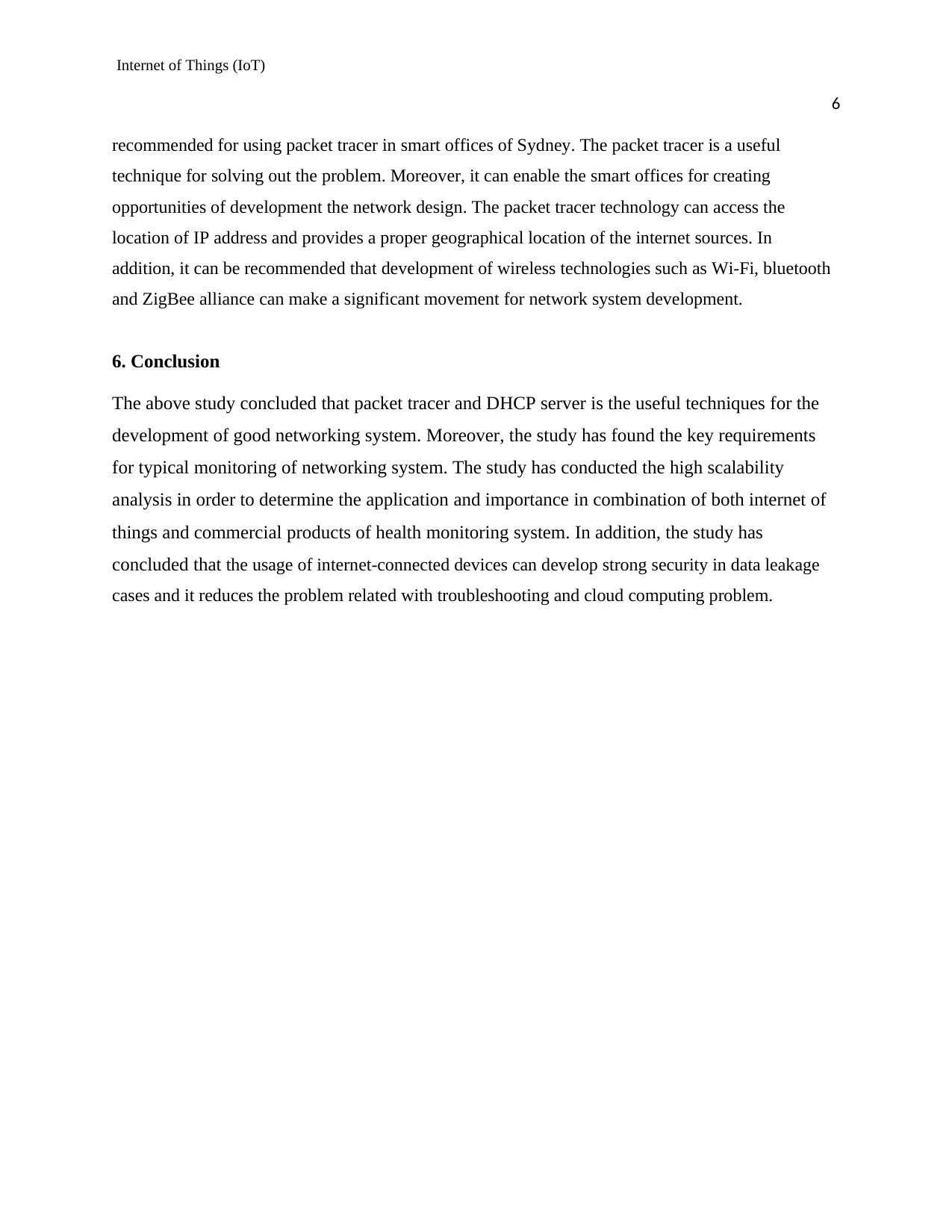
Internet of Things (IoT)
6
recommended for using packet tracer in smart offices of Sydney. The packet tracer is a useful
technique for solving out the problem. Moreover, it can enable the smart offices for creating
opportunities of development the network design. The packet tracer technology can access the
location of IP address and provides a proper geographical location of the internet sources. In
addition, it can be recommended that development of wireless technologies such as Wi-Fi, bluetooth
and ZigBee alliance can make a significant movement for network system development.
6. Conclusion
The above study concluded that packet tracer and DHCP server is the useful techniques for the
development of good networking system. Moreover, the study has found the key requirements
for typical monitoring of networking system. The study has conducted the high scalability
analysis in order to determine the application and importance in combination of both internet of
things and commercial products of health monitoring system. In addition, the study has
concluded that the usage of internet-connected devices can develop strong security in data leakage
cases and it reduces the problem related with troubleshooting and cloud computing problem.
6
recommended for using packet tracer in smart offices of Sydney. The packet tracer is a useful
technique for solving out the problem. Moreover, it can enable the smart offices for creating
opportunities of development the network design. The packet tracer technology can access the
location of IP address and provides a proper geographical location of the internet sources. In
addition, it can be recommended that development of wireless technologies such as Wi-Fi, bluetooth
and ZigBee alliance can make a significant movement for network system development.
6. Conclusion
The above study concluded that packet tracer and DHCP server is the useful techniques for the
development of good networking system. Moreover, the study has found the key requirements
for typical monitoring of networking system. The study has conducted the high scalability
analysis in order to determine the application and importance in combination of both internet of
things and commercial products of health monitoring system. In addition, the study has
concluded that the usage of internet-connected devices can develop strong security in data leakage
cases and it reduces the problem related with troubleshooting and cloud computing problem.
⊘ This is a preview!⊘
Do you want full access?
Subscribe today to unlock all pages.

Trusted by 1+ million students worldwide
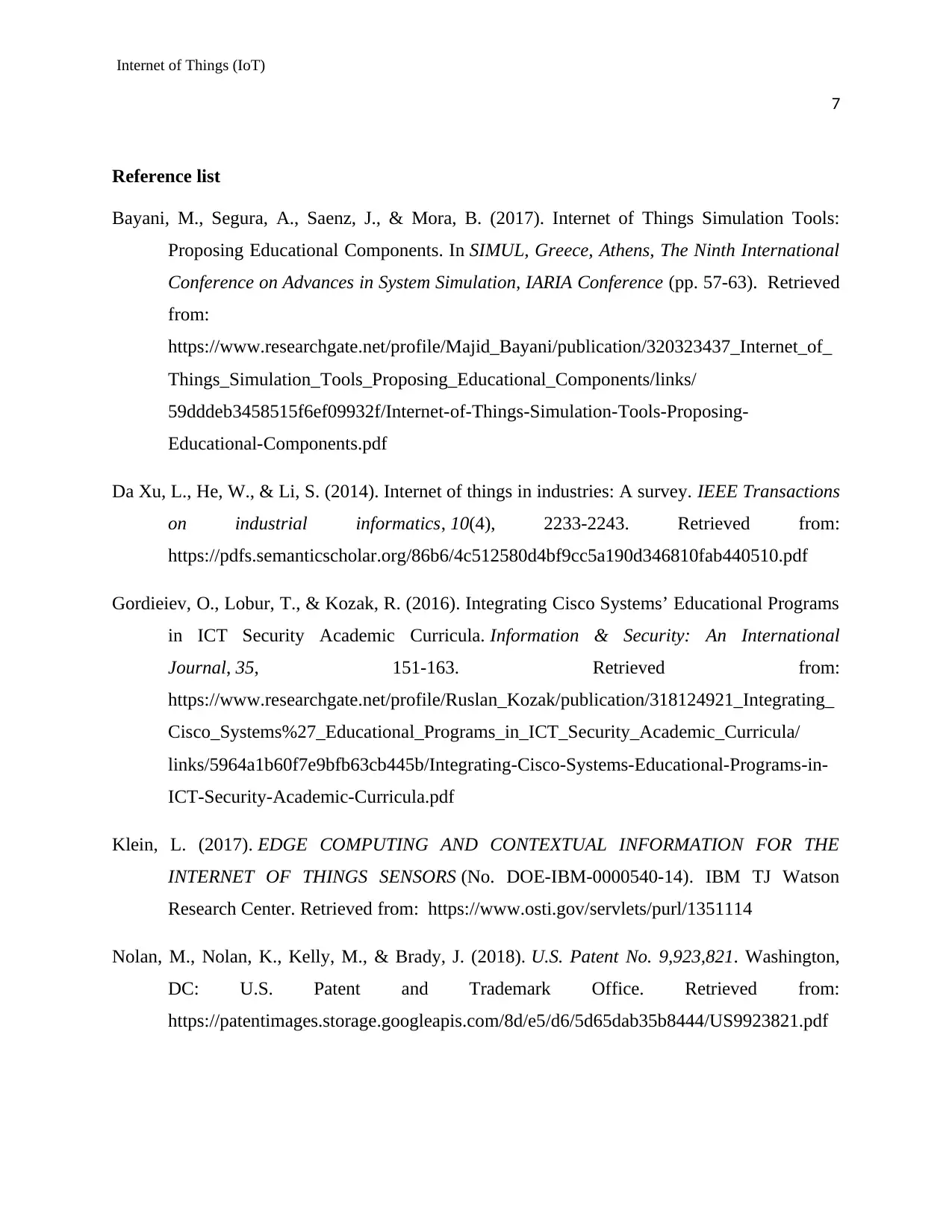
Internet of Things (IoT)
7
Reference list
Bayani, M., Segura, A., Saenz, J., & Mora, B. (2017). Internet of Things Simulation Tools:
Proposing Educational Components. In SIMUL, Greece, Athens, The Ninth International
Conference on Advances in System Simulation, IARIA Conference (pp. 57-63). Retrieved
from:
https://www.researchgate.net/profile/Majid_Bayani/publication/320323437_Internet_of_
Things_Simulation_Tools_Proposing_Educational_Components/links/
59dddeb3458515f6ef09932f/Internet-of-Things-Simulation-Tools-Proposing-
Educational-Components.pdf
Da Xu, L., He, W., & Li, S. (2014). Internet of things in industries: A survey. IEEE Transactions
on industrial informatics, 10(4), 2233-2243. Retrieved from:
https://pdfs.semanticscholar.org/86b6/4c512580d4bf9cc5a190d346810fab440510.pdf
Gordieiev, O., Lobur, T., & Kozak, R. (2016). Integrating Cisco Systems’ Educational Programs
in ICT Security Academic Curricula. Information & Security: An International
Journal, 35, 151-163. Retrieved from:
https://www.researchgate.net/profile/Ruslan_Kozak/publication/318124921_Integrating_
Cisco_Systems%27_Educational_Programs_in_ICT_Security_Academic_Curricula/
links/5964a1b60f7e9bfb63cb445b/Integrating-Cisco-Systems-Educational-Programs-in-
ICT-Security-Academic-Curricula.pdf
Klein, L. (2017). EDGE COMPUTING AND CONTEXTUAL INFORMATION FOR THE
INTERNET OF THINGS SENSORS (No. DOE-IBM-0000540-14). IBM TJ Watson
Research Center. Retrieved from: https://www.osti.gov/servlets/purl/1351114
Nolan, M., Nolan, K., Kelly, M., & Brady, J. (2018). U.S. Patent No. 9,923,821. Washington,
DC: U.S. Patent and Trademark Office. Retrieved from:
https://patentimages.storage.googleapis.com/8d/e5/d6/5d65dab35b8444/US9923821.pdf
7
Reference list
Bayani, M., Segura, A., Saenz, J., & Mora, B. (2017). Internet of Things Simulation Tools:
Proposing Educational Components. In SIMUL, Greece, Athens, The Ninth International
Conference on Advances in System Simulation, IARIA Conference (pp. 57-63). Retrieved
from:
https://www.researchgate.net/profile/Majid_Bayani/publication/320323437_Internet_of_
Things_Simulation_Tools_Proposing_Educational_Components/links/
59dddeb3458515f6ef09932f/Internet-of-Things-Simulation-Tools-Proposing-
Educational-Components.pdf
Da Xu, L., He, W., & Li, S. (2014). Internet of things in industries: A survey. IEEE Transactions
on industrial informatics, 10(4), 2233-2243. Retrieved from:
https://pdfs.semanticscholar.org/86b6/4c512580d4bf9cc5a190d346810fab440510.pdf
Gordieiev, O., Lobur, T., & Kozak, R. (2016). Integrating Cisco Systems’ Educational Programs
in ICT Security Academic Curricula. Information & Security: An International
Journal, 35, 151-163. Retrieved from:
https://www.researchgate.net/profile/Ruslan_Kozak/publication/318124921_Integrating_
Cisco_Systems%27_Educational_Programs_in_ICT_Security_Academic_Curricula/
links/5964a1b60f7e9bfb63cb445b/Integrating-Cisco-Systems-Educational-Programs-in-
ICT-Security-Academic-Curricula.pdf
Klein, L. (2017). EDGE COMPUTING AND CONTEXTUAL INFORMATION FOR THE
INTERNET OF THINGS SENSORS (No. DOE-IBM-0000540-14). IBM TJ Watson
Research Center. Retrieved from: https://www.osti.gov/servlets/purl/1351114
Nolan, M., Nolan, K., Kelly, M., & Brady, J. (2018). U.S. Patent No. 9,923,821. Washington,
DC: U.S. Patent and Trademark Office. Retrieved from:
https://patentimages.storage.googleapis.com/8d/e5/d6/5d65dab35b8444/US9923821.pdf
Paraphrase This Document
Need a fresh take? Get an instant paraphrase of this document with our AI Paraphraser
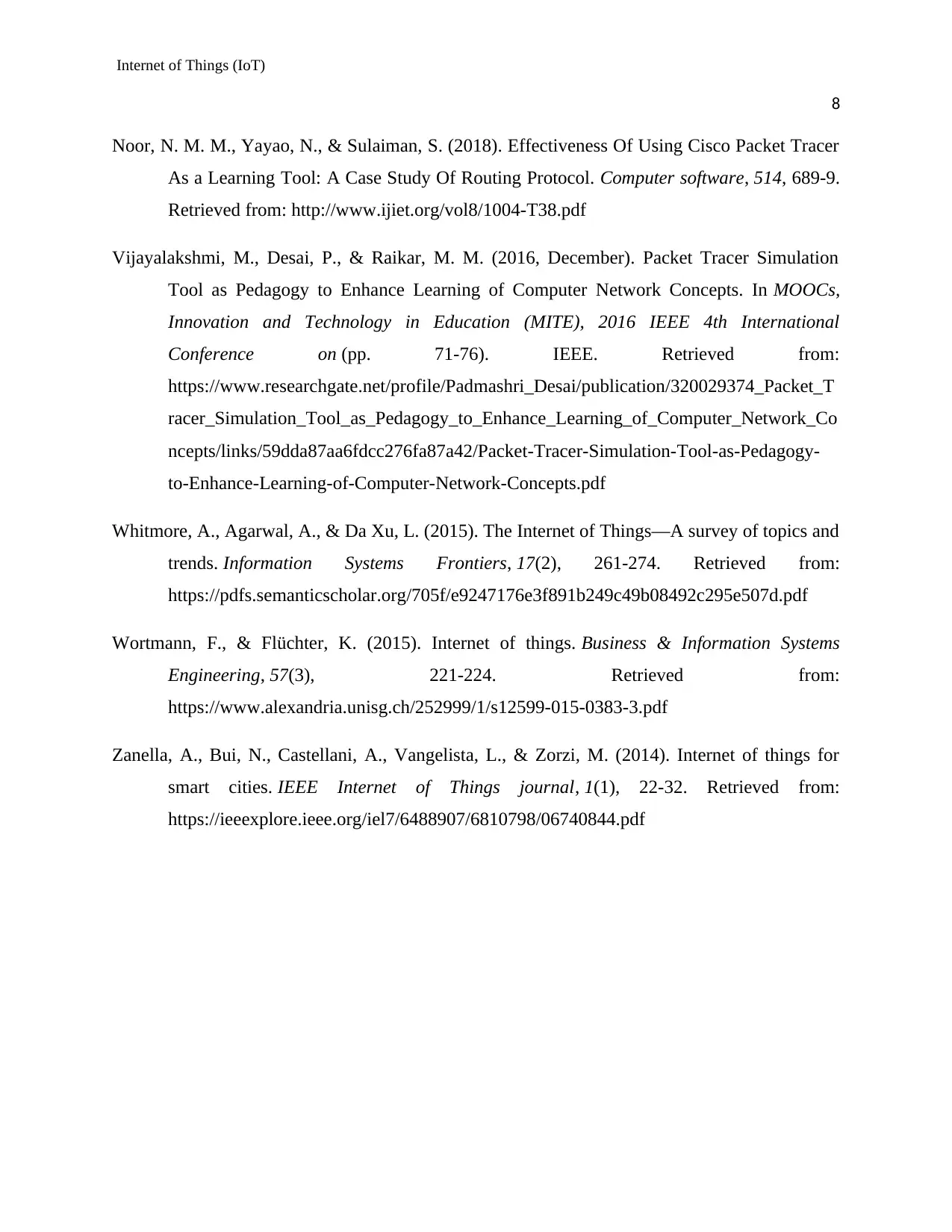
Internet of Things (IoT)
8
Noor, N. M. M., Yayao, N., & Sulaiman, S. (2018). Effectiveness Of Using Cisco Packet Tracer
As a Learning Tool: A Case Study Of Routing Protocol. Computer software, 514, 689-9.
Retrieved from: http://www.ijiet.org/vol8/1004-T38.pdf
Vijayalakshmi, M., Desai, P., & Raikar, M. M. (2016, December). Packet Tracer Simulation
Tool as Pedagogy to Enhance Learning of Computer Network Concepts. In MOOCs,
Innovation and Technology in Education (MITE), 2016 IEEE 4th International
Conference on (pp. 71-76). IEEE. Retrieved from:
https://www.researchgate.net/profile/Padmashri_Desai/publication/320029374_Packet_T
racer_Simulation_Tool_as_Pedagogy_to_Enhance_Learning_of_Computer_Network_Co
ncepts/links/59dda87aa6fdcc276fa87a42/Packet-Tracer-Simulation-Tool-as-Pedagogy-
to-Enhance-Learning-of-Computer-Network-Concepts.pdf
Whitmore, A., Agarwal, A., & Da Xu, L. (2015). The Internet of Things—A survey of topics and
trends. Information Systems Frontiers, 17(2), 261-274. Retrieved from:
https://pdfs.semanticscholar.org/705f/e9247176e3f891b249c49b08492c295e507d.pdf
Wortmann, F., & Flüchter, K. (2015). Internet of things. Business & Information Systems
Engineering, 57(3), 221-224. Retrieved from:
https://www.alexandria.unisg.ch/252999/1/s12599-015-0383-3.pdf
Zanella, A., Bui, N., Castellani, A., Vangelista, L., & Zorzi, M. (2014). Internet of things for
smart cities. IEEE Internet of Things journal, 1(1), 22-32. Retrieved from:
https://ieeexplore.ieee.org/iel7/6488907/6810798/06740844.pdf
8
Noor, N. M. M., Yayao, N., & Sulaiman, S. (2018). Effectiveness Of Using Cisco Packet Tracer
As a Learning Tool: A Case Study Of Routing Protocol. Computer software, 514, 689-9.
Retrieved from: http://www.ijiet.org/vol8/1004-T38.pdf
Vijayalakshmi, M., Desai, P., & Raikar, M. M. (2016, December). Packet Tracer Simulation
Tool as Pedagogy to Enhance Learning of Computer Network Concepts. In MOOCs,
Innovation and Technology in Education (MITE), 2016 IEEE 4th International
Conference on (pp. 71-76). IEEE. Retrieved from:
https://www.researchgate.net/profile/Padmashri_Desai/publication/320029374_Packet_T
racer_Simulation_Tool_as_Pedagogy_to_Enhance_Learning_of_Computer_Network_Co
ncepts/links/59dda87aa6fdcc276fa87a42/Packet-Tracer-Simulation-Tool-as-Pedagogy-
to-Enhance-Learning-of-Computer-Network-Concepts.pdf
Whitmore, A., Agarwal, A., & Da Xu, L. (2015). The Internet of Things—A survey of topics and
trends. Information Systems Frontiers, 17(2), 261-274. Retrieved from:
https://pdfs.semanticscholar.org/705f/e9247176e3f891b249c49b08492c295e507d.pdf
Wortmann, F., & Flüchter, K. (2015). Internet of things. Business & Information Systems
Engineering, 57(3), 221-224. Retrieved from:
https://www.alexandria.unisg.ch/252999/1/s12599-015-0383-3.pdf
Zanella, A., Bui, N., Castellani, A., Vangelista, L., & Zorzi, M. (2014). Internet of things for
smart cities. IEEE Internet of Things journal, 1(1), 22-32. Retrieved from:
https://ieeexplore.ieee.org/iel7/6488907/6810798/06740844.pdf
1 out of 8
Related Documents
Your All-in-One AI-Powered Toolkit for Academic Success.
+13062052269
info@desklib.com
Available 24*7 on WhatsApp / Email
![[object Object]](/_next/static/media/star-bottom.7253800d.svg)
Unlock your academic potential
Copyright © 2020–2025 A2Z Services. All Rights Reserved. Developed and managed by ZUCOL.



